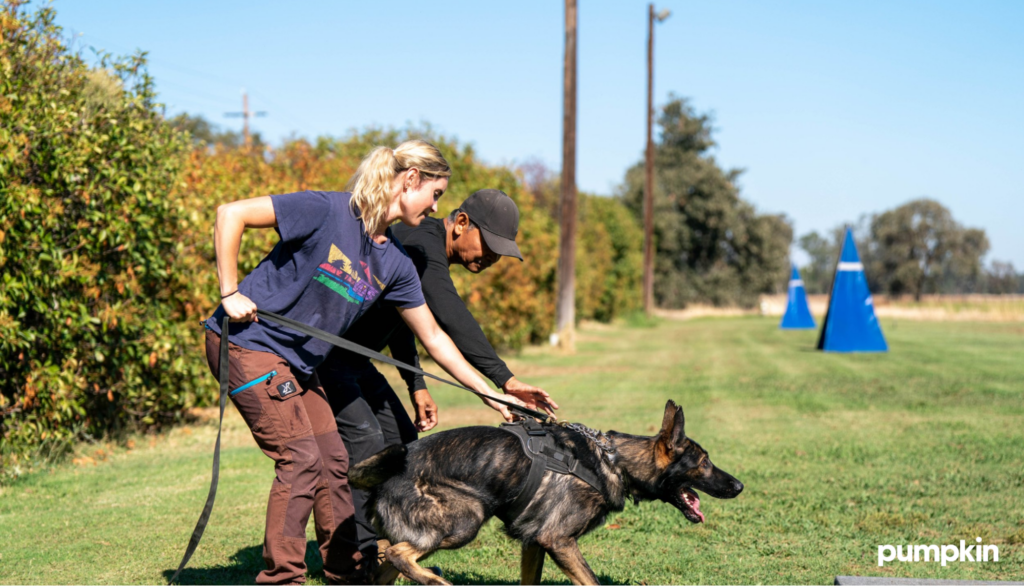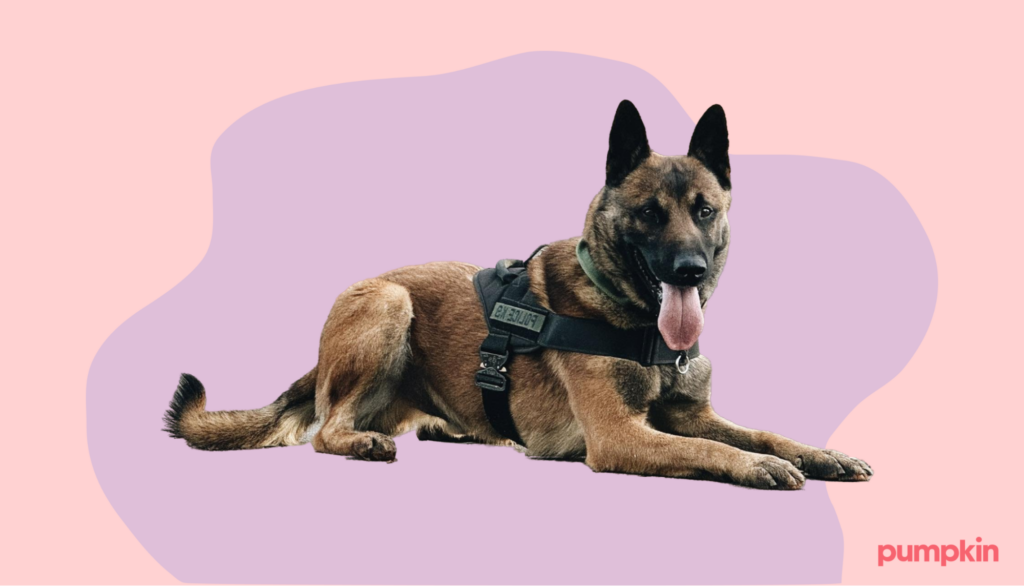Key Points
- German Shepherds excel in many roles, from herding and police work to acting in movies and television.
- Their intelligence, loyalty, and protective instincts make them great work and family dogs.
- German Shepherds require plenty of exercise and mental stimulation to live a long and healthy life.
German Shepherds are more than just handsome faces — they’re smart, they’re brave, and they’ll steal your heart (and maybe your socks). And they do have really handsome faces.
This incredible dog breed has a fascinating history, a knack for Hollywood, and unique talents that allow them to excel as both working dogs and beloved family companions.
If you love the German Shepherd breed, read on to dive into their history, health, and habits.
1. They’re born to herd
The name is a bit of a giveaway, so you might not be surprised to learn that German Shepherds were originally tasked with watching over flocks of sheep and herding them from field to field. This job required lightning-fast reflexes and an ability to run at top speed when needed.
In fact, German Shepherds are capable of reaching speeds of 30-32 mph at full sprint. To put that in perspective, they could easily outrun Usain Bolt, who tops out at 27.78 mph. However, they prefer to trot rather than run while herding. Their speed and agility have made them a go-to-dog for herding sheep, but there’s so much more to this breed than just rounding up sheep. These brave dogs will fight to protect their herd, and these instincts make them loyal and fierce working guard dogs.
2. Max von Stephanitz is the father of the breed
In 1895, Max Von Shlephanitz purchased a Shepherd Dog at a dog show, naming him Horand Von Grafath. Max saw something special in Horand, and he wasn’t wrong — this good boy became the genetic foundation for the entire German Shepherd breed.
Months later, hoping to create a distinct breed of working dog using German breeds, Max established Verein für Deutsche Schäferhunde, the first German Shepherd Dog Club. Horand, of course, was the first to register with the number SZ1, making him the first official German Shepherd.
3. They’re the 4th most popular dog breed
None of their noble work should overshadow how wonderful German Shepherds are as family members. German Shepherds are incredibly loyal, intelligent, protective, and playful. No wonder they’re the 4th most popular breed out of 193 American Kennel Club-registered breeds.
Their devotion to their humans is the stuff of Hallmark movies. Whether it’s guarding the home, snuggling on the couch, or romping around the backyard, these pups are all in when it comes to family time.
That said, these dogs are not for the faint of heart, or for first-time dog parents. They’re large, protective dogs who require daily exercise and structure. They need an owner who can keep up with them and provide enough exercise, consistent training, and early socialization.
4. European and American Breeders have different approaches
The German Shepherd officially landed in America in 1908, when the American Kennel Club (AKC) recognized the breed. By 1913, they were already crowning champions and establishing their own German Shepherd Dog Club.
American breeders developed breed standards set up by the AKC. These standards focus on body shape and elegant movements, which make German Shepherds desirable as performance and show dogs.
European breeders, on the other hand, still follow Max von Stephanitz’s breed standards, which focus on health, temperament, and agility. The German Shepherd Club of Germany oversees these standards, which require dogs to pass a series of tests. American breeding standards don’t require these tests.
5. They’re prone to some inherited and genetic diseases
Like most pure-bred dogs, these pups are susceptible to some common inherited and genetic diseases:
- Degenerative Myelopathy: A degenerative weakness in the hind legs. Luckily, DNA tests can help breeders identify and avoid passing it on.
- Von Willebrand Disease: An inherited bleeding disorder caused by the missing Von Willebrand Protein Factor.
- Exocrine Pancreatic insufficiency: A degenerative disease of the pancreas.
- Hip Dysplasia and elbow dysplasia: Painful joint problems that can make walking difficult. These conditions are genetic.
- Bloat: A life-threatening condition where the dog’s stomach fills with gas and fluid. Unfortunately, German Shepherds are predisposed to this condition.
Before you bring home your new best friend, find a responsible breeder who will have certifications and testing results for any of these genetic predispositions.
6. They can live up to 14 years
How long do German Shepherds live? On average, the German Shepherd lifespan is between 12-14 years, given they receive regular exercise, veterinary care, and eat well-balanced, healthy foods.
Their life expectancy puts them right in the mid-range for large dog breeds. To make the most of their lifespan, make sure your German Shepherd has a high-quality, balanced diet tailored to their age and activity level.
Since they are larger and more active dog breeds, they will need sufficient exercise to maintain a healthy weight and build stronger bones and muscles. Don’t forget those routine check-ups, vaccinations, and preventative care. Investing in pet insurance can also help you give your dog the best possible treatment if any unexpected health issues arise in the future.
7. They served bravely in both World Wars
In WW1, German Shepherds served alongside their German soldier counterparts as Red Cross dogs, rescuers, guard dogs, messengers, and sentries. (They even carried ammunition.)
They also led wounded and blind soldiers to safety for medical treatment. In 1917, a dog named Filax of Lewanno was honored at Westminster as a war hero after leading 54 soldiers to safety.
Their bravery and ability to perform under pressure impressed soldiers on both sides. In WWII, the United States also employed them. The U.S. military set up German Shepherd dog training centers, deploying them in what they called War Dog Platoons to work with soldiers on the battlefield. In all, there were 15 such platoons, seven in Europe and eight in the Pacific.
Later on, these four-legged heroes continued to serve in the Korean and Vietnam Wars for the United States.
8. They were the OG Guide Dogs
In 1928, Morris Frank and his German Shepherd, Buddy (formerly known as Kiss), stepped onto a busy New York street. Trained in Switzerland to assist blinded WWI veterans, Buddy skillfully guided Frank, who had lost his sight, through the crowd. Buddy’s success in navigating the street sparked a surge of interest in using German Shepherds as guide dogs for the visually impaired.
Today, most guide dogs for the visually impaired are Labs and Retrievers, who are gentle, eager to please, and easily adaptable to different environments. German Shepherds are still very good guide dogs, but their protective instincts, agility, and trainability make them a perfect fit for law enforcement and the military.
9. They have an official sport: Schutzhund
If you really want to see a German Shepherd at their best, check out Schutzhund — a sport designed to showcase their natural abilities. This sport puts dogs and their handlers through a series of demanding tests, including evaluations and training in the following categories:
- Intelligence
- Desire to work
- Bond with their handler
- Courage
- Protective instincts
- Trainability
- Sense of smell
- Perseverance
It’s like the Olympics, but for German Shepherds. With Schutzhund, they can show off their incredible skills and athleticism, and compete with other top dogs in the world.

10. They’re a dog of many names
These days, in the United States, we call them German Shepherds, but that wasn’t always the case.
After WW1, a time of political tension, many countries avoided anything German, so the AKC began calling them Shepherd Dogs in 1917. In Europe, they became Alsatian Wolf Dogs.
Many years later, both Americans and Europeans restored the original name. Now, the breed proudly stands as the German Shepherd once again.
11. They’re recognized in 11 colors
While the classic black and tan German Shepherd might be the image that first springs to mind, the AKC recognizes 11 colors as part of the breed standard.
The breed’s colors are:
- Black and Tan
- Sable
- Bi-Colored
- Black
- Black and Red
- Black and Cream
- Steele Blue
- Gray
- Panda
- White
- Liver
Interestingly, German Shepherds with colors like white, blue, and liver can’t compete in some classes at dog shows.
12. They’re double-coated and shed a lot
If you’re just welcoming a new German Shepherd into your family, be prepared to also invest in a high-quality vacuum for your “German Shedder”.
They have short to medium-length and long-haired coats, which are double-coated. Their longest coat is the overcoat, which contains longer guard hairs, and their softer, denser undercoat protects their skin from extreme heat and cold weather.
They tend to shed all year round. But don’t worry, you can keep your home (relatively) fur-free with regular brushing, at least several times a week.
13. They are the third-smartest dogs
Did you know German Shepherds are the third-smartest dog breed? Poodles and Border Collies have them beat in the brains department, but you’d never know it.
Stanley Coren, author of the book The Intelligence of Dogs, states that German Shepherds will learn a new task after only five repetitions and respond to commands correctly 95% of the time.
14. King Shepherds take the crown for size
The German Shepherd is a large breed. Males can grow to be 24-26 inches tall and weigh 65-90 lbs. Females are smaller, measuring 22-24 inches tall and weighing 50-70 lbs. They’re definitely not a lap dog (though they might try to squeeze onto your lap anyway).
But if you’re looking for a truly massive cuddle buddy, meet the King Shepherd. Bred for even greater size and stature, these males can reach an astonishing 100-150 pounds and stand 25-31 inches tall.
However, they’re not recognized by AKC, as they’re hybrid breeds of German Shepherd and Shiloh shepherds.
15. They aren’t couch potatoes
Don’t expect your German Shepherd to join you on the couch unless you’ve provided them with plenty of daily exercise and mental stimulation. Dogs who get bored, or left alone for long periods of time, can become anxious and destructive, acting out by chewing a couch cushion or destroying your shoes.
These dogs need large yards to roam around and play in. They’ll also benefit from trick training and obedience training with positive reinforcement.
Socialization is another big consideration. German Shepherds are naturally very protective of their people and tend to be wary of strangers and other dogs or animals. Socializing them as young pups helps them become well-adjusted adults who are comfortable in various situations.
16. Many German Shepherds have made history
When the World Trade Center towers fell on 9/11, Apollo was the first search-and-rescue dog on the scene. Fifteen minutes after the attack, Apollo and many other German Shepherds worked alongside their handlers at Ground Zero, despite the heat, smoke, and danger.
Fire and falling debris almost killed him, but he survived and received the prestigious Dickin Medal for gallantry and devotion to duty. Trakr, another German Shepherd at the site, found the last survivor, who was trapped for 27 hours under the rubble.
German Shepherds have also made their mark on the big screen. Strongheart, whose real name is Etzel Von Oeringern, was the first German Shepherd to appear in films. In 1921, he made his film debut in The Silent Call and also filmed Brown of the North that year. He then appeared in The Love Master and White Fang in 1925.
And don’t forget Rin Tin Tin — A WWI rescue dog turned Hollywood superstar.
After an American soldier rescued him on the battlefield in France during WW1, he went on to become the most famous German Shepherd of all time. Between 1922-1931, he appeared in 27 films and was the first non-human awarded a star on the Hollywood Walk of Fame.
Another noteworthy mention goes to Sam, the loyal German Shepherd in I Am Legend, who was played by two talented pups named Abbey and Kona. Let’s be honest, no one sat through the scene where Sam sacrifices herself without ugly crying.
17. They’re the police’s not-so-secret secret weapon
Police dogs are highly trained officers who work side-by-side with their human handlers to fight crime. German Shepherds, with their agility, strength, intelligence, and keen sense of smell, have become invaluable assets to police forces worldwide.

They’re trained in a wide range of skills, including:
- Cadaver searching
- Tracking criminals
- Search and rescue missions
- Drug and explosive detection
18. Their adorable head tilt serves a purpose
That adorable head tilt you love? It’s not just for show! The AKC identified that German Shepherds tilt their head to see and hear better.
It helps them pinpoint the exact location of a noise, whether it’s a squeaky toy or a suspicious sound coming from the bushes. It also helps improve their line of sight, especially when they’re trying to see something obscured. Sometimes, they might just be tilting their head to better stare at you.
19. The German Shepherd’s nose knows
Just when you think the German Shepherd has performed all the jobs imaginable, along comes the coronavirus. A pioneering program launched in Finland in September 2020 trained these dogs to detect coronavirus in people.
Once again, these superhero dogs proved themselves with an impressive 80%-90% accuracy rate — they could even detect subtle odor changes in asymptomatic individuals.
A most remarkable breed: The German Shepherd
As far as the perfect family dog goes, you can’t beat a German Shepherd. For those willing to put in the effort, love, and care, you’ll be rewarded with more than just a dog — you’ll have a loyal companion and a fearless protector.
FAQs
- https://blog.tryfi.com/how-fast-can-a-german-shepherd-run/
- https://www.usatoday.com/story/life/health-wellness/2023/03/21/when-running-invented-how-fast-can-humans-run-all-answers/11509278002/
- https://www.gsdca.org/breed-history
- https://www.schaeferhunde.de
- https://www.akc.org/most-popular-breeds/
- https://www.akc.org/dog-breeds/german-shepherd-dog/
- https://www.gsdca.org/
- https://www.vet.cornell.edu/animal-health-diagnostic-center/laboratories/comparative-coagulation/clinical-topics/canine-von-willebrand-disease
- https://vcahospitals.com/know-your-pet/exocrine-pancreatic-insufficiency-in-dogs
- https://gsdcv.org.au/our-breed/health/bloat/
- https://edencamp.co.uk/blog/the-unsung-heroes-of-world-war-ii-animals-in-service/
- https://www.pedigreedatabase.com/german_shepherd_dog/dog.html?id=625133-filax-of-lewanno?_v=20150409065425
- https://www.mwdtsa.org/german-shepherd-dogs-military-brief-historical-overview/
- https://news.vanderbilt.edu/2010/12/06/through-buddys-eyes/
- https://www.guidedogs.org.uk/getting-support/guide-dogs/our-breeds/
- https://vetericyn.com/blog/dog-breed-guide-the-german-shepherd/
- https://dogsacademy.org/german-shepherd-colors/
- http://gsrelite.co.uk/the-history-origin-of-the-german-shepherd-dog/
- https://mycuriouscanine.com/dog-training-for-german-shepherds/
- https://www.thesprucepets.com/king-shepherd-dog-breed-profile-4691060
- https://www.akc.org/expert-advice/news/dogs-9-11-never-heard-heroes/
- https://www.theguardian.com/world/2009/jun/18/trakr-dog-september-11-clone
- https://walkoffame.com/strongheart/
- https://www.britannica.com/topic/Rin-Tin-Tin




